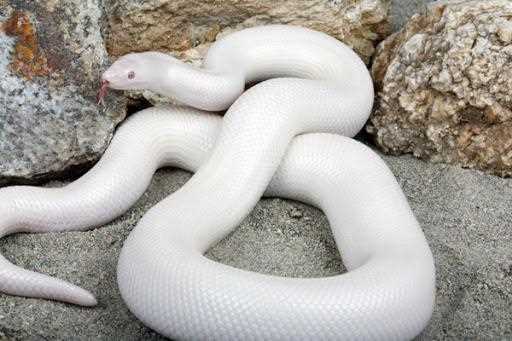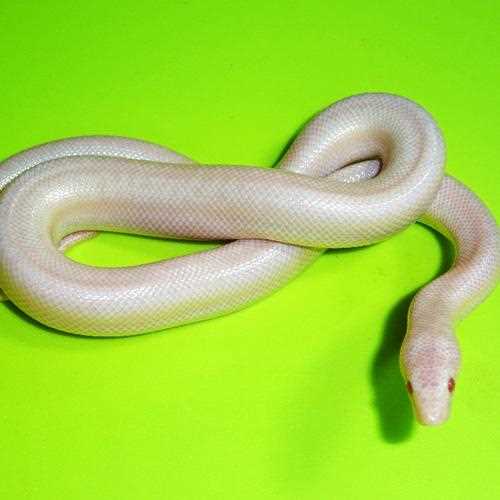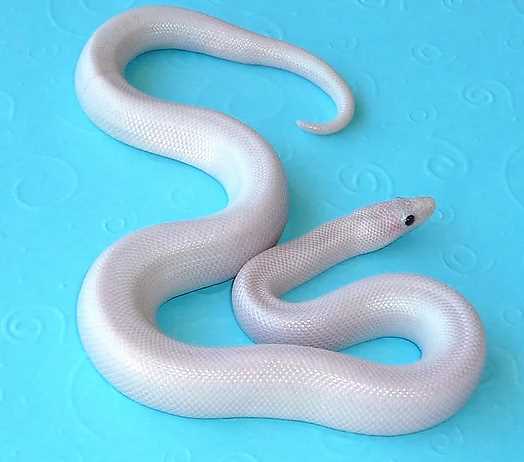
The Snow Rosy Boa is a beautiful and unique snake with its white and curled body. It is a subspecies of the Rosy Boa, which is a small and docile snake native to the southwestern United States and parts of Mexico. The Snow Rosy Boa gets its name from its snow-white coloration, which is a result of a genetic mutation.
As a cold-blooded reptile, the Snow Rosy Boa requires a specific environment to thrive. It needs a relatively small enclosure with proper heating and lighting to maintain its body temperature. The temperature gradient within the enclosure should range from 75-85°F, with a cool area of around 70-75°F. The humidity should be kept between 40-50% to prevent respiratory issues.
Snow Rosy Boa: Basic Care
Habitat
Creating the right enclosure for your Snow Rosy Boa is essential for their health and well-being. A glass terrarium or plastic tub with a secure lid works well for these small snakes. The enclosure should be properly sized to provide enough space for the snake to curl and hide comfortably.
Temperature and Humidity
Maintaining the right temperature and humidity levels is crucial for the Snow Rosy Boa’s overall health. The ambient temperature in the enclosure should range from 75°F to 85°F (24°C to 29°C) during the day, with a slight drop to 70°F to 75°F (21°C to 24°C) at night.
Provide a warm spot in the enclosure, such as an under-tank heating pad or a heat lamp, where the temperature should be around 88°F to 92°F (31°C to 33°C). This will allow the snake to regulate its body temperature properly.
The humidity in the enclosure should be maintained between 40% to 50%. You can achieve this by misting the enclosure with water daily and using a hygrometer to monitor the humidity levels.
Substrate
Feeding
The Snow Rosy Boa is a carnivorous snake and primarily feeds on small rodents such as mice and rats. The size of the prey should be appropriate for the size of the snake, usually no larger than the snake’s mid-body girth.
Handling

When picking up your Snow Rosy Boa, support their body along the length and avoid squeezing or gripping them tightly. Allow the snake to crawl through your hands and provide a calm and secure environment.
| Pros of keeping a Snow Rosy Boa as a pet | Cons of keeping a Snow Rosy Boa as a pet |
|---|---|
| – Beautiful snow-white coloration
– Low maintenance – Small and easy to handle – Fascinating reptile to observe |
– Requires specific temperature and humidity levels
– Can be picky eaters – Lifespan of up to 25 years – Can be shy and prefer solitude |
Conclusion
Overall, the Snow Rosy Boa is a stunning and unique pet snake that requires specific care to thrive. By providing the right enclosure, temperature and humidity levels, substrate, and a proper diet, you can ensure the health and well-being of your Snow Rosy Boa and enjoy their beauty for many years to come.
Snow Rosy Boa: Enclosure Setup
1. Temperature and Humidity:
Additionally, Snow Rosy Boas require a relative humidity level of around 50-60%. This can be achieved by providing a water dish in the enclosure and misting it regularly. The substrate should also be damp but not overly wet to maintain the proper humidity levels.
2. Enclosure Size and Setup:
A 20-gallon glass terrarium is usually sufficient for an adult Snow Rosy Boa, but larger enclosures are recommended if possible. The enclosure should be equipped with a secure lid to prevent your snake from escaping.
The substrate in the enclosure should be a material that allows for burrowing, such as aspen shavings or cypress mulch. This will mimic the natural habitat of the Snow Rosy Boa and provide them with a sense of security. It should be at least 2-3 inches deep to accommodate their burrowing instincts.
Provide hiding spots for your snake using rocks, logs, or commercially available hides. These can be placed on both the warm and cool sides of the enclosure to allow your snake to choose the ideal temperature and environment for themselves.
3. Lighting and UVB:
Snow Rosy Boas are primarily nocturnal and do not require UVB lighting. However, providing a natural day and night cycle with a regular light source can help regulate their internal clocks and keep them on a consistent schedule.
Remember to regularly clean and disinfect the enclosure to maintain a healthy environment for your Snow Rosy Boa. By providing the proper enclosure setup, you’ll ensure that your pet snake is happy, healthy, and thriving in their new home.
Snow Rosy Boa: Feeding and Diet
Feeding Schedule
Dietary Requirements
Feeding Techniques
When feeding a snow Rosy Boa, it is recommended to use feeding tongs or forceps. This helps to prevent accidental bites and allows for a safer feeding experience. The thawed prey should be warmed to room temperature before offering it to the snake. This can be done by placing the prey in warm water for a few minutes.
Observation and Monitoring
Hydration
Providing access to fresh water is essential for the health of a snow Rosy Boa. A shallow water dish should be available in the enclosure at all times. The water should be clean and changed regularly to prevent bacterial growth.
Overall, a proper feeding and diet regimen is crucial for the overall health and well-being of a snow Rosy Boa. By following these guidelines and providing them with appropriate prey items, you can ensure that your pet snow Rosy Boa remains healthy and happy.
Snow Rosy Boa: Handling and Temperament
Handling a Snow Rosy Boa can be a rewarding experience for both beginners and experienced snake owners. These docile and curious snakes make great pets due to their calm temperament and small size. With proper handling and care, you can develop a strong bond with your Snow Rosy Boa.
While handling your Snow Rosy Boa, it’s crucial to support their entire body, especially the midsection. This snake has a habit of curling its body into a ball when it feels threatened or insecure. By providing support, you help the snake feel safe and prevent any unnecessary stress or injury.
Remember to always wash your hands before and after handling your Snow Rosy Boa to minimize the risk of transmitting any bacteria or parasites. Also, be aware that snakes are sensitive to temperature changes, so avoid handling them if your hands are too cold or too warm.
Snow Rosy Boa: Health Concerns
Internal parasites are also a concern for snow rosy boas, especially if they are wild-caught or housed with other reptiles. Regular fecal exams should be performed by a veterinarian to check for the presence of parasites and to determine the appropriate treatment if necessary.
Overfeeding is another health concern for snow rosy boas. These snakes have slow metabolisms and can easily become overweight if fed too frequently or with food items that are too large. Overweight snakes can develop a variety of health issues, including fatty liver disease. Stay on a regular feeding schedule and monitor your snake’s body condition to ensure they are maintaining a healthy weight.
Snow Rosy Boa: Breeding and Reproduction
Reproductive Behavior:
Snow Rosy Boas have unique reproductive behavior compared to other snake species. They are ovoviviparous, meaning that the offspring develop within eggs inside the mother’s body until they are ready to hatch. The females give birth to live young instead of laying eggs.
Mating usually occurs in the winter months when the temperatures drop. The male will court the female with gentle nudges and flicking his tongue to pick up scent cues. Once the female is receptive, mating takes place, and the male may engage in a behavior called “tail-chasing,” where he follows the female, curled up with her tail intertwined.
Gestational Period:
The gestational period for Snow Rosy Boas is approximately four to six months. During this time, the female will require proper nutrition and a consistent temperature gradient to ensure the development of healthy offspring.
Preparing for Birth:
Birth and Care of Neonates:
When the time comes, the female Snow Rosy Boa will give birth to live babies. The neonates, or baby snakes, are fully formed and capable of independent survival. They will instinctively slither away from the birthing site and begin exploring their surroundings.
It is essential to provide a separate enclosure for the neonates to prevent accidental harm from the adult snakes. The enclosure should have suitable hiding spots, a shallow water dish, and a temperature gradient that mimics their natural habitat.
Conclusion:
Rosy pet snake: Common Mistakes to Avoid
1. Incorrect enclosure temperature:

One of the most important aspects of caring for a Snow Rosy Boa is maintaining the proper enclosure temperature. These snakes require a temperature gradient, with a warm side ranging from 85°F (29°C) to 90°F (32°C) and a cool side ranging from 75°F (24°C) to 80°F (27°C). It is crucial to provide a temperature gradient to allow your snake to regulate its body temperature effectively.
2. Improper humidity levels:
3. Inadequate hiding spots:
All snakes, including Snow Rosy Boas, need secure hiding spots in their enclosure. These hiding spots should be provided on both the warm and cool side of the enclosure to allow your snake to feel safe and secure. Failure to provide adequate hiding spots can lead to stress and anxiety in your pet snake.
4. Overfeeding:
5. Handling too frequently:
While Snow Rosy Boas can tolerate handling, they are generally more solitary and prefer to be left alone. Handling your snake too often can cause stress and may lead to defensive behavior, such as biting. Limit handling to a minimum and always allow your snake time to adjust to its new environment before attempting to handle it.
By avoiding these common mistakes, you can provide the best care possible for your Snow Rosy Boa. Remember to always do thorough research and consult with a reptile veterinarian for any specific care questions or concerns.
Additional Tips and Recommendations for Snow Rosy Boa Care
If you have a Snow Rosy Boa or are considering getting one as a pet, there are some additional tips and recommendations to keep in mind to ensure their health and happiness.
1. Provide a Properly Sized Enclosure
2. Maintain the Ideal Temperature and Humidity Levels
Snow Rosy Boas require specific temperature and humidity levels to thrive. The enclosure should have a warm side and a cool side, with a heat source such as an under-tank heating pad or ceramic heat emitter. The warm side should be kept at around 80-85°F (26-29°C), while the cool side should be around 70-75°F (21-24°C). The humidity level should be kept between 40-50%.
3. Offer a Variety of Hiding Spots
4. Provide a Suitable Substrate
5. Establish a Consistent Feeding Schedule

6. Handle with Care
When handling your Snow Rosy Boa, it is essential to be gentle and calm. These snakes can be sensitive to rough handling, so always support their body and avoid grabbing or squeezing them. Regular handling can help them become more comfortable with human interaction.
7. Regular Health Check-ups
Just like any other pet, regular health check-ups are important for the overall well-being of your Snow Rosy Boa. Schedule regular visits with a reptile veterinarian to ensure that your snake is healthy and to address any potential health concerns.
8. Research and Educate Yourself
Researching and educating yourself about Snow Rosy Boas is crucial for their proper care. Stay informed about their natural habitat, behavior, and common health issues. Join online forums or reptile communities to interact with experienced Snow Rosy Boa owners and learn from their experiences.
By following these additional tips and recommendations, you can provide the best possible care for your Snow Rosy Boa and enjoy the presence of this beautiful white-colored reptile as a pet.

I’m Lena Adams—a product of an unconventional upbringing in the African wilderness. My father, a daring explorer of African wildlife, sparked my fascination with reptiles, a passion that intertwined with the tragic loss of my mother during an expedition, leaving an indelible mark on my life. Driven to understand the creatures that captivated my parents, I embarked on my journey, sharing insights about reptiles, frogs, and lizards on my website. Through my explorations and conservation efforts, I honour my family’s legacy while seeking connections—to the creatures, nature, and the mother whose presence I yearn to understand.
